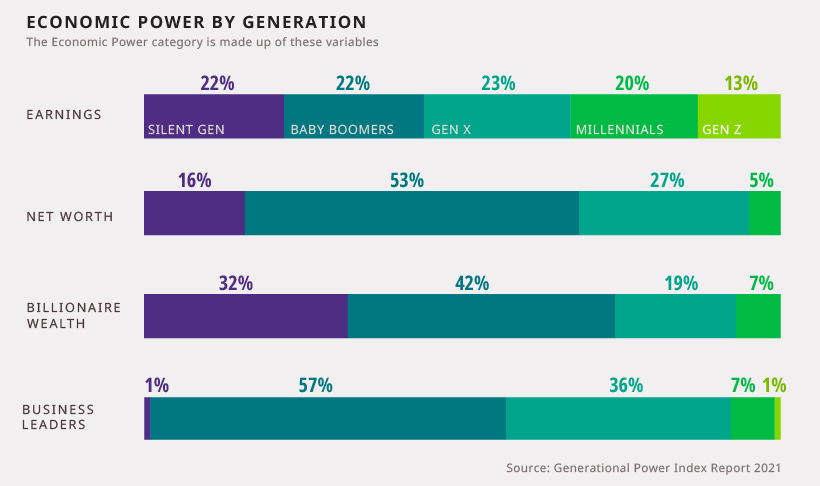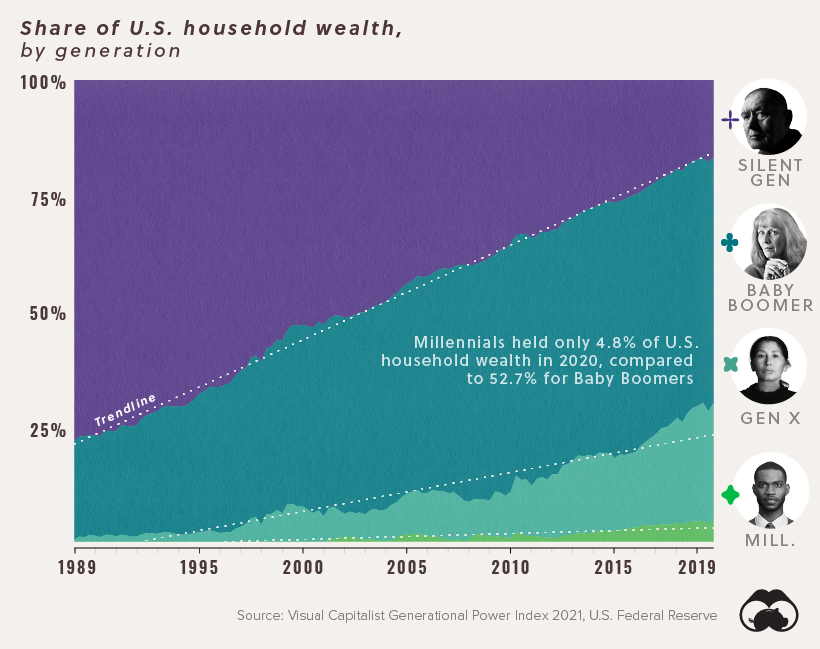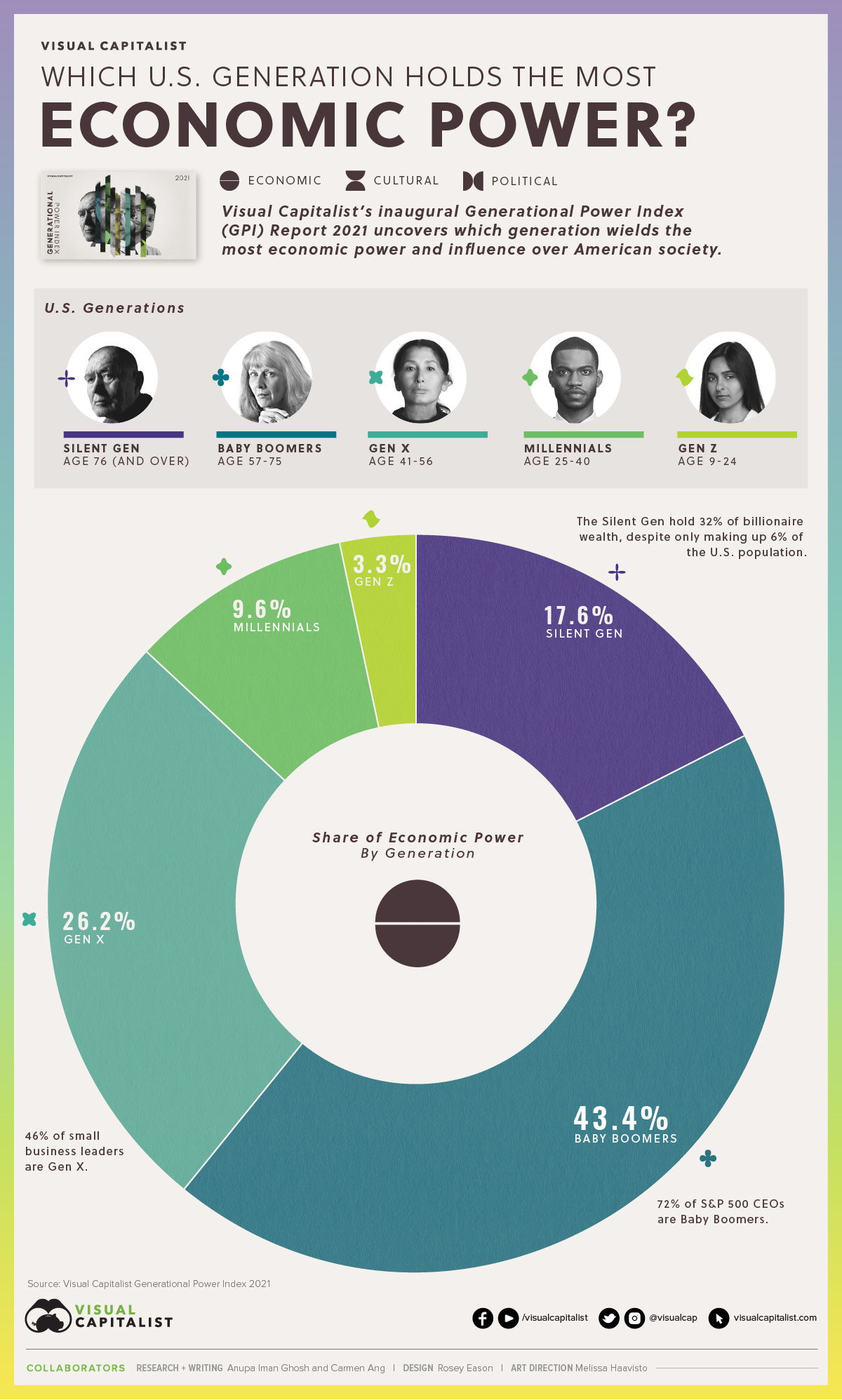Which U.S. Generation Wields The Most Economic Power?
In our inaugural Generational Power Index (GPI) 2021, we’ve ranked generations on how much power and influence they hold in American society.
And when it comes to money and economic power, our research has concluded that Baby Boomers, those between the ages of 57-75, have more influence than Millennials, Gen X, and Gen Z combined.
| Generation | Economic Power Share |
|---|---|
| Baby Boomers | 43.4% |
| Gen X | 26.1% |
| Silent | 17.6% |
| Millennials | 9.7% |
| Gen Z | 3.3% |
These findings may seem intuitive, but what exactly contributes to economic power? To find out, let’s take a closer look at the GPI’s underlying variables.
The Building Blocks of Economic Power
Our starting point was to define the age ranges of each generation:
| Generation | Age range (years) | Birth year range |
|---|---|---|
| The Silent Generation | 76 and over | 1928-1945 |
| Baby Boomers | 57-75 | 1946-1964 |
| Gen X | 41-56 | 1965-1980 |
| Millennials | 25-40 | 1981-1996 |
| Gen Z | 9-24 | 1997-2012 |
| Gen Alpha | 8 and below | 2013-present |
Using these ranges as a framework, we then calculated our four underlying variables of economic power. Here’s what the distribution within each one looked like:

The earnings variable represents the median weekly earnings of full-time workers in the U.S., and was the most evenly distributed of the four variables. Gen Z had the lowest median weekly earnings ($614), while Gen X had the highest ($1,103).
Boomers established a clear lead in the second variable, net worth, which represents each generation’s share of overall U.S. wealth. As it turns out, Boomers hold 53% of all wealth in the country—more than all other generations combined.
The third variable captures each generation’s share of billionaire wealth, and was dominated by Boomers and the Silent Gen. We calculated this variable by starting with the top 1,000 billionaires globally, then filtering for Americans only.
The final variable, business leaders, is based on two underlying metrics: the generational share of both S&P 500 CEOs and small business owners. This enabled us to capture data from two sides of the business spectrum to see who holds power there.
Download the Generational Power Report (.pdf)
Shifting Dynamics in Economic Power
America’s wealth distribution is not stagnant, meaning the balance of economic power shifts with each passing year. Keeping this in mind, here are two of the most compelling trends that we discovered while analyzing data for the GPI report.
1. Younger Generations Show Sluggish Growth
The following chart illustrates each generation’s share of household wealth over time.

It makes sense that Baby Boomers would hold the most wealth of any generation. They have had more time to accumulate assets, and the population of Boomers is roughly three times higher than that of the Silent Generation.
What’s more interesting, however, is the stark difference in wealth trajectories between Boomers and younger generations.
While Boomers entered the workforce in a prosperous post-WWII era, Millennials and Gen Z have either started their careers in the aftermath of the 2008 Financial Crisis, or in the midst of the COVID-19 pandemic.
To put it in perspective, when Baby Boomers were as old as today’s Millennials in 1989, they held 21.3% of U.S. wealth. That’s more than four times higher than what Millennials hold now.
2. Small Business: The 99.9%
America’s small businesses may not have the same scale as global corporations like Apple or Amazon, but they are an incredibly important part of the U.S. economy.
In fact, small businesses make up 99.9% of all U.S. companies, and employ one-third of the nation’s workforce.
Here is who runs small businesses, from a generational perspective:

The 13% share held by Millennials may not sound too impressive, but it is one of the cohort’s strongest areas for economic power.
Looking forward, it seems entrepreneurship will grow into an area of strength for both Millennials and Gen Z, who are 188% more likely to want to create a side business compared to older generations.
Combine this with the fact that e-commerce adoption has been accelerating even faster than expected due to the pandemic, and it’s easy to see how younger, more tech-savvy generations could quickly expand their influence.
(Click on image to enlarge)

Disclosure: None.



